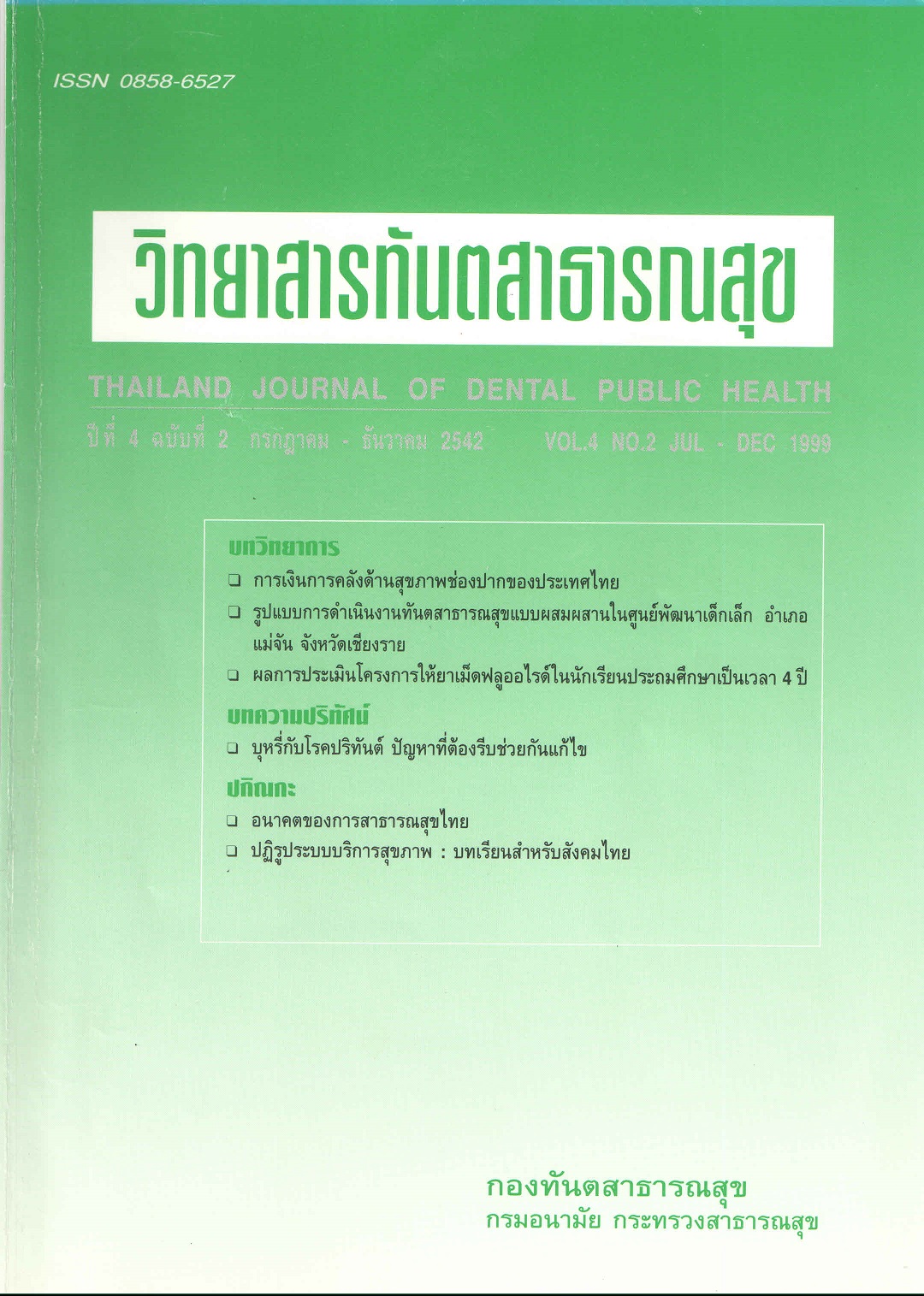Oral health financing in Thailand.
Main Article Content
Abstract
This document research, gathering various sources of data and database about oral health expenditure, behavior and outcomes during 1988 -1998, aimed to 1) analyze value and trend of oral health expenditure from 2 major sectors: household and government and 2) assess the achievement in oral health due to national investment. The results were as following
Monthly oral health expenditure of household continued increasing during 1988 - 1996 and dropped in 1998. But the proportions of monthly expenditure to total consumption were quite consistent (0.5-0.6 %). Yearly per capita toothbrush and toothpaste expenditure (87.5 Bahts in 1998) was more than of dental treatment (25.3 Bahts). Yearly per capita oral health expenditure was increasing tendency since 1988 and decreased in 1998. Its highest increasing rate was between 1990-1992. In 1998, oral health expenditure of people in Bangkok metropolis was highest, then those in central, south or north and northeast which were 257.0, 116.4, 88.9, 82.7 and 73.6 Bahts/person/year respectively. Among areas, people in municipal area paid higher than those in sanitary and village areas which were 132.7, 104.2 and 81.0 Bahts/person/year respectively.
Each year, government budget was allocated for dental treatment more than oral disease prevention. Remarkably, the prevention proportion continued increasing since 1988 to be equaled the treatment proportion in 1992 then slightly higher whereas the treatment proportion was inversely direction. The investment was found lack of equity since government spent in municipal area more than sanitary district and rural area. Even though value of oral health budget was increasing, it was steadily decreasing proportion in total health budget from 2.7 in 1988 to be 2.3 % in 1996. However, oral health budget were quite consistent proportioning to gross domestic product (GDP) which were between 0.02 (1988-1992) - 0.03 % (1994-1996).
At national level, overall expenditure from all sources as well as yearly per capita for oral health were increasing during each 2-years (89.1, 100.2, 122.4, 131.6 and 142.4 Baht/person/year, respectively). Proportioning to GDP, total oral health expenditure mainly came from people and slowly decreased and was compensated by increased government expenditure. Although the value of oral health promotion expenditure was more than treatment, its proportion was decreasing whereas that of the treatment was inversely increasing.
Oral health and risk behaviors were tooth brushing with fluoride dentifrice, consumption risky foods of dental caries and cigarette smoking which was periodontitis risk. Proportion of tooth brushing more than 2 times per day were increasing as well as consumption sugar cane and risky foods but a number of people in all age groups did not brush before bedtime. Smoking rate in each sex and age group tended to decrease and the starting age falling into the smoking also decreased. For dental service, dental extraction still was the main service which all groups of people received.
Achievement on oral health was conducted from comparing the whole investment to people's oral health status. Providing dental treatment was obviously success especially for primary school student and could preserve more permanent teeth. However, tooth loss in other groups still was important problem particularly in 17-18 aged group which the denture requirement would be followed. Increasing percentage of caries and periodontal disease affected in all aged groups stated that oral disease prevention was quite failed. Oral health problem may be more serious in the future if most of financing agencies especially specific welfare programs still tend to prior treatment rather than promotion and prevention. In addition, oral health promotion and disease prevention strategies would be reconsidered and reconstructed.
Downloads
Article Details
References
2. กองทันตสาธารณสุข การประเมินผลแผนงานทันตสาธารณสุขในแผนพัฒนาการสาธารณสุข ตามแผนพัฒนาเศรษฐกิจและสังคมแห่งชาติ ฉบับที่ 6 ปีพ.ศ. 2530-2534 กรมอนามัย กระทรวงสาธารณสุข 2534
3. สํานักงานประกันสุขภาพ สํานักงานปลัดกระทรวงสาธารณสุข โครงการบัตรประกันสุขภาพกระทรวงสาธารณสุข กระทรวงสาธารณสุข 2541 เอกสารอัดสําเนา
4. สํานักงานประกันสุขภาพ สํานักงานปลัดกระทรวงสาธารณสุข งานรักษาพยาบาลผู้มีรายได้น้อยและผู้ที่สังคมควรช่วยเหลือเกื้อกูล เอกสารประกอบการประชุมระดมความคิดเห็นเพื่อการปฏิรูปโครงการบัตรประกันสุขภาพ 3 มิถุนายน 2541 กระทรวงสาธารณสุข เอกสารอัดสําเนา
5. จารุวัฒน์ บุษราคัมรุหะ, โกเมศ วิชชาวุธ, สุณี ผลดีเยี่ยม และ สุรัตน์ มงคลชัยอรัญญา 10 ปี ทันตแพทย์ผู้ทําสัญญาของกระทรวงสาธารณสุข วิทยาสาร ทันตสาธารณสุข 2541:3(1) 54-62
6. กองทันตสาธารณสุข กรมอนามัย รายงานการประเมินผลแผนงานทันตสาธารณสุข ตามแผนพัฒนาการสาธารณสุข ฉบับที่ 7 (พ.ศ.2535-2539) กระทรวงสาธารณสุข โรงพิมพ์องค์การทหารผ่านศึกในพระบรมราชูปถัมภ์ 2541
7. กองทันตสาธารณสุข รายงานผลการสํารวจทันตสุขภาพแห่งชาติครั้งที่ 2 ประเทศไทย 2527 กรมอนามัยกระทรวงสาธารณสุข เอกสารอัดสําเนา
8. กองทันตสาธารณสุข รายงานผลการสํารวจทันตสุขภาพแห่งชาติครั้งที่ 3 ประเทศไทย 2532 กรมอนามัยกระทรวงสาธารณสุข 2534
9. กองทันตสาธารณสุข รายงานผลการสํารวจทันตสุขภาพแห่งชาติครั้งที่ 4 ประเทศไทย 2537 กรมอนามัยกระทรวงสาธารณสุข 2537.
10. World Health Organization. Evaluation of Recent Changes in the Financing of Health Services . WHO Technical Report Series : 829 Geneva , 1993.
11. Roemer M. I. Chapter 3 Health System Components and Their Relationships. In National Health Systems of the World: volume one: The Countries. Oxford University Press 1991.
12. สํานักงานสถิติแห่งชาติ รายงานการสํารวจภาวะเศรษฐกิจและสังคมของครัวเรือน พ.ศ. 2531, 2533, 2535, 2537, 2539 และ 2541 ทั่วราชอาณาจักร สํานักนายกรัฐมนตรี
13. สัมฤทธิ์ ศรีธํารงสวัสดิ์ , จริยา วิทยะศุภร และเพ็ญแข ลาภยิ่ง การลงทุนด้านสุขภาพเพื่อเด็กและเยาวชน รายงานการวิจัย 2541 เอกสารอัดสําเนา
14. นวลอนันต์ ตันติเกตุ, กิตยา มั่งเรือน, จงกล เลิศเกียรดํารง และวิโรจน์ ตั้งเจริญเสถียร การคลังเพื่อการส่งเสริมสุขภาพ รายงานการวิจัย สถาบันวิจัยระบบสาธารณสุข 2541 เอกสารอัดสําเนา
15. สํานักงานคณะกรรมการอ้อยและน้ําตาลทราย รายงานปริมาณการผลิตและการจําหน่ายน้ําตาลทรายในประเทศ กระทรวงอุตสาหกรรม กรุงเทพมหานคร 2541
16. สํานักงานสถิติแห่งชาติ รายงานการสํารวจอนามัยและสวัสดิการครัวเรือนพ.ศ. 2529, 2534 และ 2539 สํานักนายกรัฐมนตรี
17. สํานักงานสถิติแห่งชาติ รายงานการสํารวจพฤติกรรมการสูบบุหรี่ของประชากรพ.ศ. 2534 และ 2536 สํานักนายกรัฐมนตรี
18. วิโรจน์ ตั้งเจริญเสถียร, นวลอนันต์ ตันติเกตุ, พินทุสร เหมพิสุทธิ์, วงเดือน จินดาวัฒนะ และคณะ แบบแผนรายจ่ายสุขภาพภาครัฐในแผนพัฒนาการสาธารณสุขฉบับที่ 5-7 (พ.ศ. 2525-2539) รายงานการวิจัย สถาบันวิจัยระบบสาธารณสุข และสํานักนโยบายและแผนสาธารณสุข กระทรวงสาธารณสุข 2541 เอกสารอัดสําเนา
19. Qandil R. , Sandhu H.S. and Matthews D.C. Tobacco, smoking and periodontal diseases. J
Can Dent Assoc. 1997 ; 63(3) :187-195.
20. Christen A.G. The impact of tobacco use and cessation on oral and dental diseases and Conditions. Am J Med 1992; 93:255-315.
21. กองทันตสาธารณสุข รายงานผลการสํารวจสภาวะทันตสุขภาพในผู้ใช้แรงงานในพื้นที่ 5 จังหวัดรอบกรุงเทพมหานคร กรมอนามัย กระทรวงสาธารณสุข 2535.
22. Grembowski D., Fiset L. , Milgrom P. et al. Does Fluoridation Reduce the Use of Dental Services Among Adults? Med Care 1997;35(5) : 454-71 .
23. Kathryn A. A. A Comparison of Quality in a Dual-choice Dental Plan : Capitation versus Fee-for-service. J Public Health Dent 1990;50(3):186-93 .
24. Stein R. M. Lessons from Medicine: An Economist's Perspective. Dent Education 1996;60(4): 368-72.


